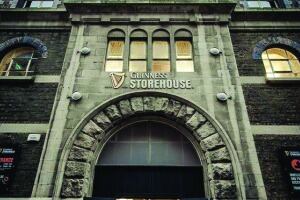On a whirlwind tour of some of Ireland’s new small craft breweries I found myself one evening in the pretty coastal town of Dingle, the most westerly place in the British Isles. I’d arrived there for bed and board following my last brewery visit of the day to the Beoir Chorca Duibhne.
That’s the West Kerry Brewery to thee and me. It’s in an area where Irish not English is the first language and I was agreeably surprised to find in the Tig Bhric Inn next to the tiny brewery both Golden Ale and Porter served by that most iconic symbol of Englishness, beer engines and handpumps. The landlord, Paul ÓLoingsigh, extolled the virtues of cask conditioning and allowing beer to ripen in the cellar.
Cynical
With the taste of his rich, hoppy and liquorice-edged Porter still coating my tastebuds I went on to Dingle and wandered that evening into a pub full of music, laughter and craic.
A kindly soul pressed a glass of stout into my willing hands. “That’s superb,” I said. “Which small Irish craft brewery makes this?”
You can guess what’s coming. “Some guy in Dublin,” a voice said, “named Arthur Guinness.”
In other words, Guinness still cuts the mustard. I’ve never been a member of the cynical fraternity that believes big brewers can’t make decent beer. Some of them don’t make much of an effort, but Guinness is cut from different cloth.
I was supping the Dublin brew in Dingle, just a few miles from the bar where, back in 1971, four Englishmen on holiday were inspired by several glasses of Arthur’s finest to launch the Campaign for Real Ale when they returned home.
Revolution
I’m an unashamed fan of Guinness Foreign Extra Stout or FES for short. It’s a 7.5% bottled beer that’s the base brew for even stronger versions of Guinness sold in many parts of Africa and the Caribbean. In the early 19th century, it was the beer the good Arthur designed for the export market and it helped turn the Dublin brewery into the biggest in the world for a while before the lager revolution took centre stage.
The beer was first called Stout Porter, for it was based on the London beer style of Porter that transformed brewing in the 18th century. Guinness hired a London brewer to show him how to make Porter and he also learned that the strongest versions of the style were dubbed Stout.
Porter became the drink of the working man in Dublin. It was nicknamed Plain to distinguish it from the stronger Stout and it was immortalised in the work of two Irish writers, Flann O’Brien and J P Donleavy. O’Brien, in a memorable newspaper column, recorded one drinker telling another in a Dublin pub: “A pint of Plain is your only man” while Donleavy wrote: “When I die I want to be buried in a vat of Guinness Porter and taken round all the pubs in Dublin.”
Clamour
Porter eventually went out of fashion on both sides of the Irish Sea and Stout became “your only man”. But now Guinness has restored the tradition with two versions of Porter that are based on recipes culled from the pages of ancient brewers’ books.
There’s no doubt that Guinness has been prompted to launch the beers in response to the rise of new craft breweries in Ireland. It’s a trend in both this country and the US as global brewers are forced to recognise the world-wide beer revolution and the clamour for products with taste and character.
In Dublin, Guinness has installed a pilot brewery as “a home to innovation and craft... a hub of beer exploration.” Brewers have dug deep into old records to produce two beers, Dublin Porter and West Indies Porter. Guinness says the beers have been inspired by recipes in records dating from the late 1700s and early 1800s.
Dublin Porter (3.8%) is based on a recipe from 1796 while the West Indies version dates from 1801. It’s 6% and the high level of alcohol and hops kept it in good condition on a long sea journey to the Caribbean.
Authentic
If cynics say the beers are a clever marketing con, I would direct them to the brilliantly-conceived museum, the Guinness Storehouse in Dublin, which contains a wealth of artefacts and memorabilia of brewing in the 18th, 19th and 20th centuries.

The brewery’s records are available and I have no doubt about the authenticity of the beers, though I would query whether Dublin Porter would have measured a modest 3.8% in 1796.
Back then, beers were known as “liquid bread” and were a vital source of protein for people with poor diets who were doing hard manual labour.
But let’s not be churlish. This a welcome innovation by the Dublin brewery and it’s to be regretted that modern health rules won’t permit it to augment the beers with a famous slogan from the past: “Guinness Is Good For You”.
